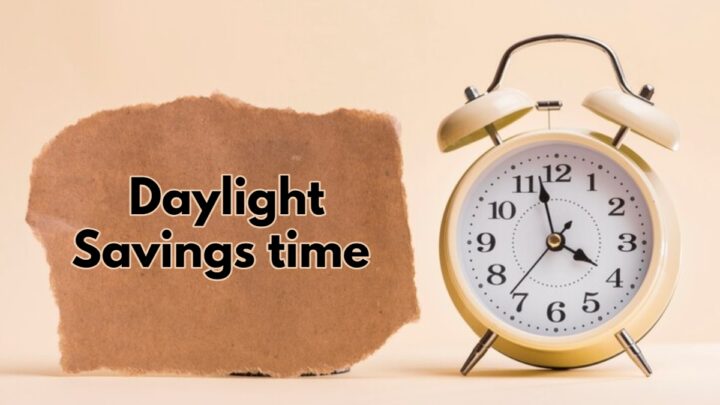Nature is a beautiful artist who paints a canvas full of amazing things that improve our lives. Ponder the warm touch of sunlight and the changing seasons – nature provides us with both beauty and use. In this quilt of natural wonders, we’ll continue to consider how time and daylight interact. Let’s move on to something more interesting: Daylight Saving Time (DST). It’s similar to how a clock responds to make the most of sunlight. Try modifying the schedule to make the most of the daylight. Some governments are considering abandoning this tradition, and we’ll look at why and what it implies for them. Let’s look at the causes for this and what occurs when states decide to alter things.Â
“Die beste Zeit für einen Neuanfang ist jetzt.” This German saying means “The best time for a new beginning is now.” It reflects the ever-renewing nature of the world around us. As we explore the realms of Daylight Saving Time, let this saying serve as a reminder that every shift in time brings the opportunity for a fresh start, much like the changing seasons in nature. So let us jump into this very interesting topic!
What will you see here?
Know more about Daylight Savings Time

Ah, the odd-time dance known as Daylight Saving Time! Keep in mind that this is a seasonal twist in which we dance with the clock, choreographing a ballet of hours to make the most of the gentle presence of daylight.
In its forever drive for efficiency, humanity decided to play with time as the sun moved across the sky. Enter the magical world of leaping ahead and falling back. In the spring, we excitedly advance our clocks, taking an hour from the sunrise and stashing it in the evening’s treasure chest. This provides us with the gift of increased daylight, as if Mother Nature herself decided to add a little more sunlight to our lives. But hold on, as autumn whispers its arrival, we find ourselves reversing the ritual. We bid farewell to that borrowed hour, letting it return to its celestial origin. The days may grow shorter, but fear not, for we’ve stockpiled moments of daylight throughout the sun-kissed months.
What is the significance of this timeless art? It’s a classical praise of efficiency and conservation. We dance in tune with our planet’s natural rhythm by aligning our waking hours with the sun’s brilliant rays. It’s a choreography designed to brighten our days and save energy, a ballet that spans the seasons and invites us to enjoy the sun. So, while we twirl through this annual time warp, let us take a moment to appreciate the beauty of Daylight Saving Time.
State Legislative Update

In the U.S., the yearly Daylight Saving Time (DST) routine kicks off on the second Sunday in March. That’s when we cheerfully push our clocks forward by an hour. The reverse happens on the first Sunday in November, signaling the end of DST as we set our clocks back to standard time. Now, here’s the scoop on what’s happening across states. Lawmakers are in a bit of a puzzle about whether we should keep flipping our clocks. Over the past few years, many states toyed with the idea of sticking to either standard time or daylight saving time all year round. Picture this: since 2015, about 450 bills and resolutions have been thrown into the mix in almost every state. But the real breakthrough came in 2018 when Florida said, “Hey, we’re going to do DST all the time,” but they’re waiting for the big bosses in Congress to give them the green light.
Fast forward to the last five years, and 19 states have jumped on the bandwagon. They passed laws or made resolutions saying they wanted daylight saving time all year if Congress gave the nod. The catch? Congress needs to say it’s okay before any state can actually make the switch. Now, a couple of outliers, Arizona and Hawaii, plus some U.S. territories, have said, “Nope, we’re sticking to standard time all the time.” They’re the cool rebels who don’t play the daylight-saving time game. So, that’s the lowdown on-the-clock shenanigans happening across the U.S.!
States that passed Permanent Daylight Savings Time
Certainly, let’s delve into more details about each state that has taken steps regarding Daylight Saving Time (DST):
- Alabama (2021): Passed legislation indicating a preference for year-round DST.
- California (2018): Voters authorized the change in 2018, but legislative action is pending, awaiting federal approval.
- Colorado (2022): Enacted legislation expressing a desire for permanent DST.
- Delaware (2019): Passed legislation indicating a preference for year-round DST.
- Florida (2018): Became the first state to enact legislation for year-round DST, contingent on federal approval.
- Georgia (2021): Passed legislation signaling an inclination for year-round DST.
- Idaho (2020): Passed legislation to adopt permanent DST.
- Louisiana (2020): Passed legislation indicating a preference for year-round DST.
- Maine (2019): Passed legislation expressing a desire for year-round DST.
- Minnesota (2021): Passed legislation indicating a preference for year-round DST.
- Mississippi (2021): Passed legislation signaling an inclination for year-round DST.
- Montana (2021): Passed legislation indicating a preference for year-round DST.
- Ohio (2020): Passed a resolution expressing support for permanent DST.
- Oregon (2019): Passed legislation expressing a desire for year-round DST.
- South Carolina (2020): Passed legislation indicating a preference for year-round DST.
- Tennessee (2019): Passed legislation expressing a desire for year-round DST.
- Utah (2020): Passed legislation to adopt permanent DST.
- Washington (2019): Passed legislation expressing a desire for year-round DST.
- Wyoming (2020): Passed legislation to adopt permanent DST.
These states have taken legislative action to explore or support the possibility of observing DST throughout the year. However, the actual implementation is contingent on changes to federal law, and the situation remains dynamic.
Implementation Issues
The decision of whether to implement permanent Daylight Saving Time (DST) involves various factors, and the states that haven’t done so yet may cite a range of reasons for their stance, some of which are explained in detail below:
Federal Approval Requirement

States need approval from the federal government, specifically from Congress, to make the switch to permanent DST. Some states might be waiting for a change in federal law before taking action.
Coordination with Surrounding States

In some cases, states may prefer to coordinate their timekeeping with neighboring states. They might be waiting for a regional consensus or for surrounding states to enact similar legislation.
Uncertainty and Legislative Processes

Implementing a change in timekeeping is a significant decision. States might be in the process of carefully considering the implications and potential challenges before fully committing to permanent DST.
Public Opinion and Stakeholder Input

States often seek public input and consider the opinions of various stakeholders before making significant changes. If there’s a lack of consensus or if the public shows divided opinions, states may delay implementation.
Logistical and Technological Considerations

Shifting to permanent DST involves logistical and technological adjustments, including updates to various systems and infrastructure. States may be assessing the feasibility and cost-effectiveness of such changes.
Pending Studies and Assessments

Some states might have commissioned studies or assessments to better understand the potential impacts of permanent DST on various aspects of life, such as energy consumption, health, and commerce.
Prioritization of Other Issues

State legislatures are often dealing with a multitude of issues and priorities. The decision to implement permanent DST might not be at the top of the agenda, and states could be focusing on other pressing matters.
Political Considerations

Making daylight saving time (DST) permanent is like trying to untie a knot while blindfolded – it’s complicated, people! You have to evaluate so many various aspects, from elected leaders’ lofty goals and great visions to the nitty-gritty specifics of how this will function in practice. Not to mention the thoughts of the great unwashed masses who may have strong feelings one way or the other. It’s enough to make you insane! But, hey, states are bravely plowing ahead, attempting to navigate all of these twists and turns to determine whether a permanent DST is truly worth the bother. Buckle up, because it’s going to be a wild journey!
Does Daylight Saving Time affect all countries?
You thought Daylight Saving Time was a worldwide phenomenon? Think again! Some countries, it turns out, aren’t quite as obsessed with soaking up the rays as the rest of us. In reality, DST adoption and death vary greatly across the globe. Not to mention tropical paradises within the equator, which have roughly the same amount of daylight throughout the year, so why try adjusting their clocks? They appear to be saying, “Nah, thanks, we’ll stick to our steady supply of vitamin D from the sun.” So, the next time someone asks if DST is global, just wink and answer, “Well, not quite… but hey, more power to those who try.”
When does Daylight Saving Time start and end?
Oh, the beautiful British custom of interfering with our sleep cycles! Every year, we have to advance or reverse those annoying watches by one hour, depending on the season. And, why not, when you think about it? Everything is done to maximize natural light, dear! Daylight Saving Time (or DST as we cool cats call it) begins in the United Kingdom on the very last Sunday in March, about a quarter past midnight (well, I mean 1 am GMT).
Don’t forget to set your clocks forward, or you’ll be late for tea! And just when you thought things couldn’t get any more exciting we hit the hay again on the last Sunday in October, this time returning those annoying hours to their rightful place (2 am BST, duh).
Keep in mind that these dates might shift somewhat from year to year, so double-check them before getting too snug under those warm blankets. After all, nothing ruins a good nap like arriving an hour early (or late…delete as applicable). So, my friends, keep alert!
Does Daylight Saving Time affect health?
The age-old dispute about Daylight Saving Time (DST): does it lighten our days or leave us weary and confused? Let us explore this fascinating topic and discover some unique ideas that may throw light on its impact on our well-being. Prepare to nerd out with me as we investigate the intricate relationship between Daylight Saving Time and our collective health!
- Sleep Disruption: The Great Time Heist! The sneaky thief of sleep, entering our lives and altering our schedules like a cruel clown. As the hours pass, our bodies struggle to adjust, like ragdolls in a game of cosmic pinball. Suddenly, what was once a peaceful night’s sleep transforms into a chaotic war in which the forces of fatigue combat the invading army of awake. It’s a frustrating cycle, but don’t worry – with a little patience (and possibly a few more cups of coffee), we’ll emerge victorious, ready to face whatever the day brings.
- Increased Health Risks: As a matter of fact, hidden beneath the seemingly innocuous transition from Standard Time to Daylight Saving Time lies the potential for significant health issues. Research suggests that following the time change, there may be an uptick in cardiovascular events such as heart attacks, strokes, and accidents. The notion is that the alteration disrupts our internal biological rhythms, causing unpredictable consequences throughout the body. Therefore, it would be wise to exercise caution and prepare oneself for possible challenges when Daylight Saving Time commences.
- Impact on Mental Health: Sleep patterns and internal biological clocks, known as circadian rhythms, are critical to mental health. When these normal cycles change, some people may experience mood swings or become more angry as a result of the transition period.
- Adaptation: It is worth noting that everyone reacts differently to daylight savings time changes, with some feeling no effect while others are more sensitive to noticeable changes.
Conclusion
Why the clock charade? It’s a timeless art, praising efficiency and conservation, aligning our waking hours with the sun’s brilliance. This ballet spans seasons, inviting us to savor the sun and brighten our days. But why haven’t all states implemented it? Some wait for federal approval, while others prioritize coordination with neighboring states or consider public opinions and logistical challenges. Reflecting on this curious time dance, let’s appreciate the beauty of Daylight Saving Time, acknowledging the complexity of its implementation and the ongoing debates.
As we conclude, let’s embrace change with a new quote: “In every change, in every falling leaf, there is some pain, some beauty. And that’s the way new leaves grow.” It’s a reminder that, like the changing seasons, every adjustment brings both challenges and beauty.
















